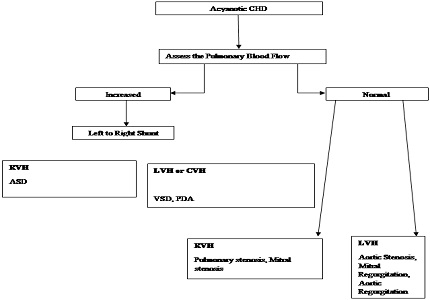Clinical accuracy of post graduate student in diagnosing congenital heart diseases (CHD) using an algorithmic approach and its comparison with echocardiography
Abstract
Background: Congenital heart diseases (CHDs)are an important cause of morbidity and mortality in children. In view of poor availability of resources in developing nations like India, clinical evaluation of children with CHD is important.
Aim: To study the clinical accuracy of post graduate student in diagnosing congenital heart diseases and its comparison with echocardiography.
Subjects and Methods: A prospective cross-sectional study performed in the Department of Pediatrics of a tertiary level teaching hospital in central India. Participants were children with CHDs attending outpatient department or admitted in wards or PICU. History, general physical and cardiovascular examinations were recorded by the post graduate student. Chest X-ray and ECG were obtained. These findings were used to classify the defect using an algorithm and a clinical diagnosis was made which was matched with echocardiography. Kappa coefficient test was used to judge the degree of agreement between the two methods.
Results: 80 patients with CHDs were included in the final analysis. 49 (61.25%) had acyanotic CHDs and ventricular septal defect (VSD) was the most common defect (n= 24, 30%) while tetralogy of Fallot (TOF) was the most common (n=14, 17.5%) cyanotic CHD. Concordance of clinical diagnosis and echocardiography was maximum for VSD (16/24, 66.6%) in acyanotic group and TOF (8/14, 57%) in cyanotic group. Kappa’s coefficient test analysis also showed an "almost perfect" area of agreement for VSD (κ=0.87) and fair area of agreement for TOF (κ=0.65). For type of CHD (cyanotic or acyanotic) and type of ventricular hypertrophy (left, right or biventricular) it showed “almost perfect” and“fair” area of agreement respectively. Conclusion: Agreement between echocardiography and cclinical diagnosis of CHDs including hemodynamic parameters like type of ventricular hypertrophy and pulmonary arterial hypertension was reasonably accurate in our study.
Downloads
References
2. Gupta I, Gupta ML, Parihar A, Gupta CD. Epidemiology of rheumatic and congenital heart diseases in school children. J Indian Med Assoc. 1992 Mar;90(3):57-9. [PubMed]
3. Vashishtha VM, Kalra A, Kalra K, Jain VK. Prevalence of congenital heart disease in school children. Indian Pediatr 1993; 30: 1337-1340. [PubMed]
4. Jose VJ, Gomathi M. Declining prevalence of rheumatic heart disease in rural schoolchildren in India: 2001-2002. Indian Heart J. 2003 Mar-Apr;55(2):158-60. [PubMed]
5. Lahariya C, Paul VK. Burden, differentials, and causes of child deaths in India. Indian J Pediatr. 2010 Nov;77 (11): 1312-21. doi: 10.1007/s12098-010-0185-z. Epub 2010 Sep 10. [PubMed]
6. Iyer PU, Moreno GE, Fernando Caneo L, Faiz T, Shekerdemian LS, Iyer KS. Management of late presentation congenital heart disease. Cardiol Young. 2017 Dec;27(S6):S31-S39. doi: 10.1017/S104795111 7002591. [PubMed]
7. Saxena A. Pediatric cardiac care in India: current status and the way forward. Future Cardiol. 2018 Jan;14(1):1-4. doi: 10.2217/fca-2017-0084. Epub 2017 Nov 23.
8. Joseph K Perloff. The clinical recognition of congenital heart disease.3rd ed. New Delhi: Jaypee Brothers; 1988. Chapter 1, Introduction: formulation of the problem; p1-7.
9. McHugh ML. Interrater reliability: the kappa statistic. Biochem Med (Zagreb). 2012;22(3):276-82.
10.Viera AJ, Garrett JM. Understanding interobserver agreement: the kappa statistic. Fam Med. 2005 May;37 (5):360-3. [PubMed]
11. Subhi MD. Diagnostic accuracy of clinical diagnosis versus echocardiography in evaluating heart murmurs in Iraqi children. Saudi Med J 2006;27 (5): 672-675.
12. Gessner IH. What makes a heart murmur innocent? Pediatr Ann. 1997 Feb;26(2):82-4, 87-8, 90-1. [PubMed]
13. Patel A, Tomar NS, Bharani A. Utility of physical examination and comparison to echocardiography for cardiac diagnosis. Indian Heart Journal 2017;69:141–145.
14. Colman R, WhittinghamH, Tomlinson G, Granton J. Utility of the Physical Examination in Detecting Pulmonary Hypertension. A Mixed Methods Study. PLOS ONE 2014;10(9): e108499.
15. Reddy A, Jatana SK, Nair MNG. Clinical evaluation versus echocardiography in the assessment of rheumatic heart disease. MJAFI 2004; 60 : 255-258. [PubMed]
16. Kapoor R, Gupta S. Prevalence of congenital heart disease, Kanpur, India. Indian Pediatr. 2008 Apr;45(4):309-11. [PubMed]
17. SalahAIbrahim ,MohammedH.Abdelrahman ,Osama H Elshazali. Pattern anddiagnosis of congenital heart disease in patients attending AhemadGasim Cardiac Center. Sudan JMS 2012 Dec; 7(4):249-254.
18. Reddy R, Taksande A. Clinical profile of congenital heart disease in a tertiary care hospital in central India. Journal of Datta Meghe Institute of Medical Sciences University 2016 Jun; 11(1): 81-86
19. Ashraf M, Chowdhary J, Khajuria K, Reyaz AM. Spectrum of congenital heart diseases in Kashmir, India. Indian Pediatr. 2009 Dec;46(12):1107-8. [PubMed]
20. Kemper AR, Mahle WT, Martin GR, Cooley WC, Kumar P, Morrow WB, et al. Strategies for implementing screening for critical congenital heart disease. Pediatrics 2011; 128(5):1259–1267. [PubMed]
21. Diller CL, Kelleman MS, Kupke KG, Quary SC, Kochilas LK, Oster ME. A ModifiedAlgorithm for CriticalCongenital Heart DiseaseScreening Using Pulse Oximetry. Pediatrics.2018 May;141(5). pii: e20174065. doi: 10.1542/peds.2017-4065.
22. Elgendi M, Bobhate P, Jain S, Guo L, Rutledge J, Coe Y et al. The voice of the heart: vowel-like sound in pulmonary artery hypertension. Diseases 2018 Apr 13; 6(2): e26.
23. Butman SM, Ewy GA, Standen JR, Kern KB, Hahn E. Bedsidecardiovascularexamination in patients with severechronic heart failure: importanceofrest or induciblejugularvenousdistension. J Am Coll Cardiol.1993Oct;22(4):968-74. [PubMed]
24. Drazner MH, Hellkamp AS, Leier CV, Shah MR, Miller LW, Russell SD, Young JB, Califf RM, Nohria A. Value of clinicianassessment of hemodynamics in advancedheart failure: the ESCAPE trial. Circ Heart Fail.2008Sep;1(3):170-7. doi: 10.1161/CIRCHEARTFAILURE.108.769778. [PubMed]

Copyright (c) 2018 Author (s). Published by Siddharth Health Research and Social Welfare Society

This work is licensed under a Creative Commons Attribution 4.0 International License.


 OAI - Open Archives Initiative
OAI - Open Archives Initiative


